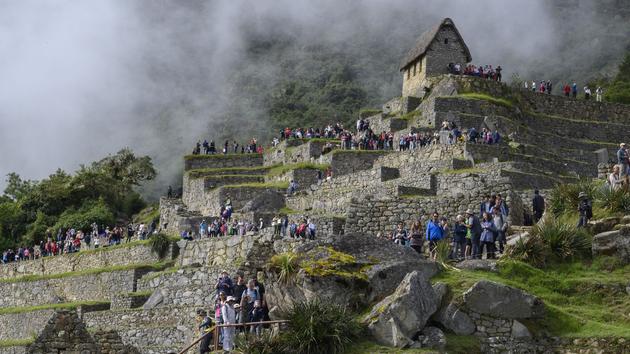Enchanting, majestic, mystical: there is no shortage of superlatives to evoke Machu Picchu. The mythical Inca citadel, perched on a peak at 2,430 meters above sea level, has become a must for world tourism. Its attendance has even tripled since the 1990s to reach one and a half million visitors in 2018.
But this international success has, as always, its downside. The preservation of vestiges from the 15th century, discovered in 1911 by an American explorer and listed as world cultural heritage by Unesco in 1983, is threatened by mass tourism. A recent episode sadly illustrated this: Peru arrested in January 6 tourists, including one French, for damage during a night illegally spent among the ruins. In response, the authorities decided to install 18 additional surveillance cameras from February, in addition to the 6 already existing on the site.
Unesco has been worried about the future of the hilltop city for over ten years. The threat of inscription on the list of endangered world heritage in August 2019 has therefore prompted the Peruvian authorities to review the conditions of access.
»Read also - Quotas, taxes, bans ... Measures of 12 destinations against overtourism
Regulate flows
If a lot of communication has been made around a "limitation" of the number of tickets giving access to Machu Picchu from 2017, the ceiling of 5,940 visitors per day is, in fact, roughly equal to the historical maximum recorded . On the other hand, a real effort has been made since to smooth attendance over the day and thus limit congestion.
While most tourists previously concentrated on the morning, and no time limit was imposed, three periods (morning, noon, afternoon), each covering three different hours of entry, have been imposed since early 2019, i.e. around 600 people per hour, broken down from 6 a.m. to 2 p.m. The presence among the ruins is also limited to 4 hours. Travelers wishing to spend the day there must now purchase two tickets. Finally, it is imperative to be accompanied by a guide, personal or group.
The tourism market in Peru has experienced very steady growth for the past ten years, from 5 to 10% per year
Stéphane Coudassot, director of the Gaston-Sacaze agency specializing in tourism in South America"These measures seem rather welcome to me because they have made it possible to regulate access to respond to a real problem of overload" , testifies to Le Figaro Stéphane Coudassot, director of the agency Gaston-Sacaze, specialized in tourism in South America . As for the establishment of predefined circuits among the remains of the Inca city, it is not, according to him, as restrictive as it seems. “The authorities wanted to protect certain fragile areas. The site is so large and fascinating that you don't feel the constraint, ”he believes.
The stated objective is, of course, to preserve the centuries-old walls but also to improve the experience of tourists by reducing the queues to get in and out of places by bus, which could sometimes exceed an hour. On the other hand, it is more than ever advisable to book your entry as early as possible, especially during the high season (from July to October).
The airport of discord
An airport should be built from June to replace that of Cuzco, too small to support the influx of tourists. 111206271 / sharptoyou - stock.adobe.com
In this context, the project to build a new international airport in Chinchero about sixty kilometers from Machu Picchu, to replace that of Cuzco, small and saturated, is causing concern for part of the local population. The stated objective is indeed to increase the accessibility of the region, which concentrates the tourist jewels of the country: Machu Picchu of course but also the Inca Trail (Qhapaq Ñan), the Sacred Valley and the city of Cuzco, a delightful blend of colonial architecture and Inca remains. The new infrastructure would have a capacity of 6 million visitors per year, 60% more than the existing airport.
The demand is there. "The tourism market in Peru has experienced very steady growth over the past ten years, from 5 to 10% per year," emphasizes Stéphane Coudassot. And tourists who do not go to Machu Picchu and its region are extremely rare ” . In 2018, more than 100,000 French people went to Peru. "This country benefits from a very positive image with our compatriots and tourism from France follows the overall upward trend" , continues Stéphane Coudassot.
The Peruvian government, sponsor of the airport project, made a commitment at the end of January to Unesco to provide, before the start of works planned for June, a study of the impact on this invaluable cultural heritage.
An ecological sanctuary in danger
But man is not the only threat to the integrity of Machu Picchu. Its natural environment is also damaged by the heavy rains and fires recorded in recent years in the protected area of 35,000 hectares which surrounds it. In an attempt to limit landslides, the Peruvian government launched a massive reforestation operation in early January: a million trees should be planted over the next ten years in this so-called “cloud forest”, because it is tropical humid, typical of the region. A welcome initiative to preserve the splendor of this ecological sanctuary. So that a visit to Machu Picchu remains an unforgettable experience.
»In video, Mass tourism: waste is piling up on Machu Picchu

